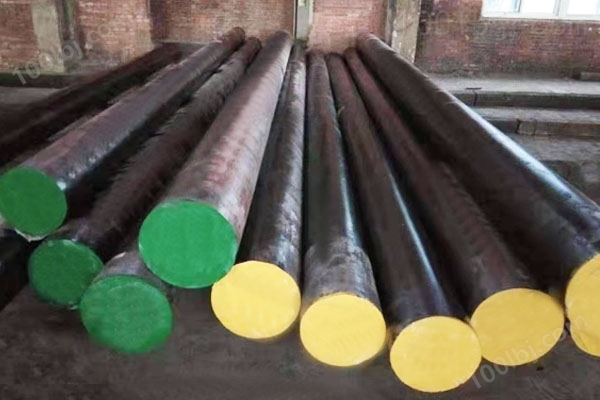品牌
生产厂家厂商性质
唐山市所在地
了进步大型、超大型自由锻件钢锭的匀称性与纯净性,中国一重集成创新发明了一系列冶炼及铸锭手艺。
⑴低硅控铝钢冶炼手艺。
为了削减同化物并获取本质细晶粒钢,发明了低硅控铝钢生产手艺。既进步了钢液的纯净度、得到本质细晶粒钢,另有效地控制了超大型钢锭的成分偏析,低落钢锭中的同化物和善体含量。采用低硅控铝钢冶炼浇注技巧生产出了成分匀称、同化物少的高品质锻件。
⑵保护浇注。
1)新型中间包。
为了削减钢锭浇注历程当中钢渣卷入钢锭模内,模仿了冶金行业连铸历程当中采用“挡墙”、“挡坝”的履历,发明了带有“挡墙”、“挡坝”的新型中间包。数值模拟和工程实际证明,相比于古代的圆形中间包,新型中间包浇注的超大型钢锭中的同化物含量大幅度削减。
2)长水口保护浇注。
浇注历程当中注流卷吸空气是钢液二次氧化的紧张缘故。钢液二次氧化不但会形成无益的氧化物同化导致锻件报废,并且还会使钢锭中的气体(H 、O 、N)含量增高。而气体含量高又是导致超大型锻件缺陷的要紧缘故之一。为了幸免钢液的二次氧化,在模仿冶金行业履历的底子上,开发了长水口保护浇注手艺,有效地幸免了钢液的二次氧化。
3)二次补浇。
偏析是钢液选分结晶和钢锭凝集历程的势必后果,钢锭越大,偏析及缩孔等缺陷越紧张。中国一重在用平衡C含量为0.62%的459t钢锭研制支承辊时,曾在靠近冒口端的辊身部位发生断裂。经对断裂部位宏观形貌说明,发现二次缩孔紧张,冒口下部的C含量竟高达1.16%,靠近尺度值的2倍。为打听决这一困难,发明了钢锭二次补浇手艺,使冒口下部的C含量降至0.8%摆布,胜利生产出5m、5.5m支承辊用超大型钢锭。
锻件厂家定制哪家好,就找唐山盛通锻造有限公司。
In order to improve the symmetry and purity of large and super large free forging steel ingots, China has integrated a series of smelting and ingot casting techniques.
(1) Low silicon controlled aluminum steel smelting technology.
In order to reduce the assimilation and obtain the intrinsic fine grain steel, a low silicon controlled aluminum steel production technique was invented. It not only improves the purity of the molten steel, but also obtains the intrinsic fine-grain steel. It also effectively controls the segregation of the composition of the super-large steel ingot, and the assimilation and good body content in the ingot. The use of low-silicon controlled aluminum steel smelting and casting techniques has produced high-quality forgings with well-balanced components and few assimilates.
(2) Protection pouring.
1) New tundish.
In order to reduce the steel slag involved in the ingot casting process, imitating the history of the “retaining wall” and “blocking dam” in the continuous casting process of the metallurgical industry, the invention of the new middle with “retaining wall” and “blocking dam” package. Numerical simulations and engineering have proved that the assimilates in the ultra-large steel ingots cast by the new tundish are greatly reduced compared to the ancient round tundish.
2) Long nozzle protection pouring.
The injection of air in the pouring process is the tension of the secondary oxidation of molten steel. The secondary oxidation of molten steel not only causes undesired oxide assimilation, but also causes the forgings to be scrapped, and also increases the content of gases (H, O, N) in the ingots. The high gas content is one of the reasons for the defects of ultra-large forgings. In order to survive the secondary oxidation of molten steel, in the imitation of the metallurgical industry resume, the development of the long nozzle protection casting technology, effectively spared the secondary oxidation of molten steel.
3) Secondary filling.
Segregation is the inevitable consequence of the selection of crystallization of steel and the agglomeration of steel ingots. The larger the steel ingot, the more tight the defects such as segregation and shrinkage. When China developed a support roll with a 459t steel ingot with a balanced C content of 0.62%, it broke at the roll body near the riser end. After explaining the macroscopic morphology of the fracture site, it was found that the second shrinkage cavity was tight, and the C content in the lower part of the riser was as high as 1.16%, which was close to twice the scale value. In order to inquire about this difficulty, the steel ingot secondary refilling technique was invented, and the C content in the lower part of the riser was reduced to 0.8%, and the ultra-large steel ingot for the 5m and 5.5m support rolls was successfully produced.
发送反馈
历史记录
